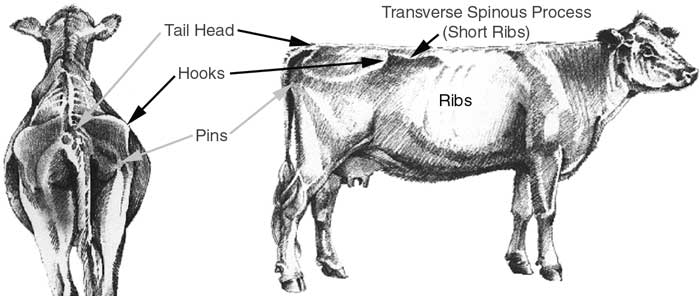
numerical scoring system 1-9 | nutritional priorities of cows | guidelines for body condition scores | importance of body condition
| Body Condition Score (BCS) | Description of Animal | Condition |
| 1 | Bone structure of shoulder, ribs, back, hooks, and pins sharp to touch and easily visible. Little evidence of fat deposits or muscling. | Emaciated |
| 2 | Little evidence of fat deposits, but some muscling in hindquarters. The spinous processes feel sharp to the touch and are easily seen, with space between them. | Very Thin |
| 3 | Fat beginning to cover over the loin, back, and foreribs. Backbone still highly visible. Spinous processes can be identified individually by touch and may still be visible. Spaces between the processes are less pronounced. | Thin |
| 4 | Foreribs not noticeable. The transverse spinous processes can be identified only by palpation to feel rounded rather than sharp. Full muscling in the hindquarters. | Borderline |
| 5 | 12th and 13th ribs not visible to the eye unless animal has been shrunk. Transverse spinous processes and spaces between are not noticeable to the eye and can be identified only with firm pressure. Areas on each side of the tail head are fairly well filled, but not rounded. | Moderate |
| 6 | Ribs fully covered, not noticeable to the eye. Hindquarters plump and full. Noticeable sponginess to covering of foreribs and each side of tail head. | Good |
| 7 | End of spinous processes can only be felt with firm pressure; spaces between can be barely distinguished at all. Abundant fat cover on either side of tail head. | Very Good |
| 8 | Animal taking on smooth, blocky appearance; bone structure disappearing from sight. Fat cover thick and spongy. | Fat |
| 9 | Bone structure not easily seen or felt. Tail head buried in fat. Mobility may actually be impaired by excess amount of fat. | Very Fat |
* All of the following pictures were used with permission from Elanco Animal Health.

Basic Anatomy
____________________________________________________________________
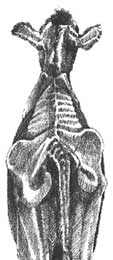 |
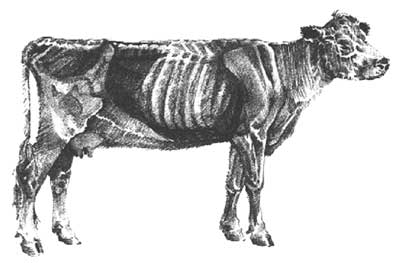 |
Body Condition Score 1
____________________________________________________________________
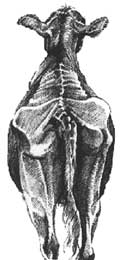 |
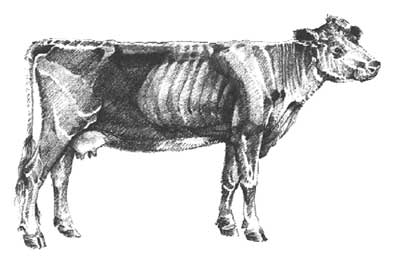 |
Body Condition Score 2
____________________________________________________________________
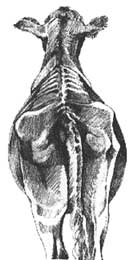 |
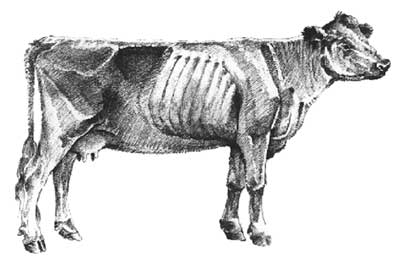 |
Body Condition Score 3
____________________________________________________________________
 |
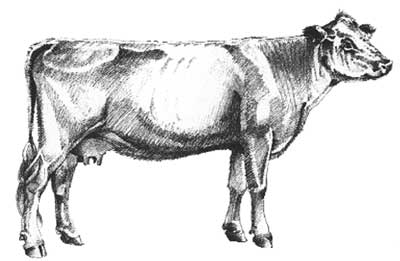 |
Body Condition Score 4
____________________________________________________________________
 |
 |
Body Condition Score 5
____________________________________________________________________
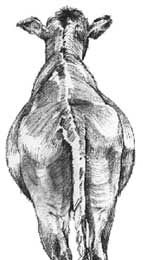 |
 |
Body Condition Score 6
____________________________________________________________________
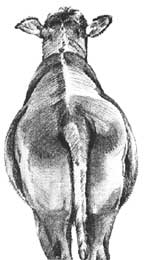 |
 |
Body Condition Score 7
____________________________________________________________________
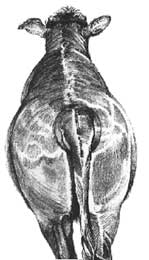 |
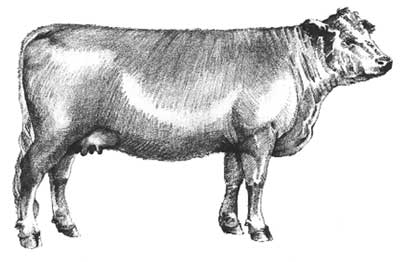 |
Body Condition Score 8
____________________________________________________________________
 |
 |
Body Condition Score 9
Introduction: Body condition scoring (BCS) is a useful management tool for distinguishing differences in nutritional needs of beef cows in the herd. This system uses a numeric score to estimate body energy reserves in the cow. Research indicates that there is a strong link between the body condition of a cow and her reproductive performance. The percentage of open cows, calving interval, and calf vigor at birth are all closely related to the body condition of cows both at calving and during the breeding season. All these factors play an important role in the economics of a beef cow-calf operation and help determine the percentage of viable calves each year. Monitoring body condition using the BCS system is an important management tool for assessing production efficiency.
Body condition scores are excellent indicators of the nutritional status in beef cows. Ideal liveweight varies from cow to cow, whereas ideal body condition (BCS 5-6) is the same for all cows. Also, body condition can be measured in the field without gathering or working cattle.
Body condition scores are numbers used to estimate energy reserves in the form of fat and muscle of beef cows. BCS ranges from 1 to 9, with a score of 1 being extremely thin and 9 being very obese. Areas such as the back, tail head, pins, hooks, ribs, and brisket of beef cattle can be used to determine BCS.
A common scoring system has been developed to estimate the average body condition of cows in a herd. This system provides producers a relative score based on an evaluation of fat deposits in relation to skeletal features.
The most widely used body condition scoring system for beef cattle in the U.S. assigns scores from 1 (emaciated and virtually no fat) to 9 (excessively fat).
Be aware that gut fill due to rumen contents or pregnancy can change the appearance of moderately fleshy cows, especially over the ribs or in front of the hooks. Visual indicators of each BCS are listed in table I. Long hair can often make it difficult to correctly evaluate the body condition score of a beef cow or heifer. When the hair on the cow is long, palpating the specific areas of fat deposition is particularly important. Cows should be palpated over the back, ribs, and over the horizontal processes of the backbone (edge of loin). "Thin" cows will have a sharper feel in these areas than cows with moderate or fat body conditions.
It is important to be aware that the breed of beef cow can have a strong influence on where body fat is deposited. For example, Bos taurus breeds and crossbreds will show a more uniform distribution of fat across the ribs, whereas Bos indicus cattle may have very little fat over the ribs but will deposit fat over the hooks and pin bones.
Table I: Reference table for body condition scores.
|
|
Body Condition Scores |
||||||||
|
Reference point |
1 |
2 |
3 |
4 |
5 |
6 |
7 |
8 |
9 |
|
Physically weak |
yes |
no |
no |
no |
no |
no |
no |
no |
no |
|
Muscle atrophy |
yes |
yes |
slight |
no |
no |
no |
no |
no |
no |
|
Outline of spine visible |
yes |
yes |
yes |
slight |
no |
no |
no |
no |
no |
|
Outline of ribs visible |
all |
all |
all |
3-5 |
1-2 |
0 |
0 |
0 |
0 |
|
Outline of hip & |
yes |
yes |
yes |
yes |
yes |
yes |
slight |
no |
no |
|
Fat in brisket and flanks |
no |
no |
no |
no |
no |
some |
full |
full |
extreme |
|
Fat udder & patchy fat |
no |
no |
no |
no |
no |
no |
slight |
yes |
extreme |
Nutritional Priorities of Cows:
Individual herds vary by breed, frame, or type (i.e., English or Continental) but their nutritional priorities are similar. When nutrient intake fulfills the highest priority requirements, the excess is used to fill lower priority requirements. When all current requirements are fulfilled, the excess is stored as fat.

Most English and Continental beef breeds tend to deposit excess fat externally (subcutaneous), whereas dairy and Brahman-influenced breeds deposit more fat internally (KPH or mesenteric). During periods of low energy intake, excess external body fat is the first body tissue used to meet nutritional requirements. When energy is insufficient, fat stores may not be enough to fulfill requirements. When this happens, muscle (protein) is broken down to satisfy energy demand.
Guidelines for Body Condition Scores
On average, most beef cows score in the range of 3 to 7 throughout the year. A cow is expected to be in optimal body condition (BCS 5-7) before calving. She may lose condition after calving and possibly into the breeding season. She may gain condition and weight as weaning approaches (assuming there is adequate forage) and continue gaining fetal weight and any needed body condition in late gestation.
Body condition should be evaluated 60-90 days before calving. By assigning BCS scores at this time, the cows can be sorted for appropriate feeding. Grouping cows by feed requirements and feeding them accordingly can help each of them reach BCS 5-7 by calving. Scoring cows 60-90 days before calving allows the producer to evaluate the dry cow nutritional program while allowing enough time prior to calving for "emergency feeding" if needed. Although body condition should be evaluated at calving, it may be difficult to increase body condition since lactation requires most of the energy a cow consumes. If environmental conditions at the time of calving are mild, cows may be able to reach BCS 5 or 6 by breeding time. However, this is unlikely to occur when the weather is cold or high quality feeds are limited.
Liveweight should not solely be used as an indicator of nutritional status of beef cows in a herd. Research indicates that body condition is a more reliable indicator of nutritional status than liveweight. Most herds have cows that range in age, frame size, and muscling, all of which impact the weight of the animals. Therefore, only using liveweight may over- or under-estimate the amount of body fat. Liveweight is also affected greatly by gut fill and pregnancy. Weight and body condition will vary depending on the physiological state of the cow, forage quality and availability, and the body condition of the cow.
In order to manage a beef cow-calf operation in the most cost-efficient way, producers must be aware of the body condition of their herd. Research indicates that the body condition of beef cows is related to many critical aspects of production such as conception rate, days to estrus, calving interval, and milk production. When cows are extremely thin (BCS < 4), they are not only reproductively inefficient, but they are more susceptible to health problems. Cows at BCS 1 are in a life-threatening situation and need immediate attention. Cows that are over-conditioned (BCS 8-9) are the most costly to maintain. Two-year-olds with BCS 8-9 may encounter dystocia (calving difficulty) due to the excessive fat in the pelvic area. Table II lists many of the production problems associated with cows and heifers in "thin" or "fat" condition.
Table II: Problems associated with "thin" or "fat" body condition.
|
Thin Condition BCS 1- 4 |
Fat Condition BCS 8-9 |
|
1. Failure to cycle |
1. Costly to maintain |
|
2. Failure to conceive |
2. Increased dystocia |
|
3. Increased calving interval |
3. Impaired mobility |
|
4. Increased days to estrus |
4. Failure to cycle |
|
5. Decreased calf vigor |
5. Failure to conceive |
Failure to conceive is the most important factor contributing to the reduction of net calf crop. Conception rates are dramatically compromised in cows that are BCS 4 or less. Research indicates that the body condition of a cow influences days to first estrus after calving and calving interval. A beef cow must conceive within 82 days of the birth of her calf to maintain a 12-month calving interval. Figure 1 illustrates that 91% of the beef cows with BCS >5 at calving showed signs of estrus by 60 days post-calving, whereas only 61% of beef cows with BCS 4, and only 46% of beef cows with BCS <3 showed estrus. The percentage of cows cycling by 80 days postpartum is an important factor affecting calving interval. The rectangular box in Figure 1 shows the critical breeding time in order to achieve a 12-month calving interval. This figure demonstrates the differences in postpartum cyclicity for beef cows at different condition groups. Calving interval is a function of many aspects of reproduction, including conception rate and percent cyclicity. If the cows are not cycling, they are not going to conceive, which lengthens the calving interval and negatively impacts profits.
Figure I: Effect of Body Condition and Cycling after Calving (Adapted from Wiltbank, 1983.)

Nutritional Programs Using Body Condition Scores
Since feed costs make up roughly 60% of the cost of a cow-calf operation, different feeding programs can be used to achieve the best reproductive performance without high costs. Choosing a calving season that is most compatible with your forage program is the first step in maximizing cow condition and reproduction. Understand that the changes that occur in body weight and condition are normal in the production cycle of the cow.
Table III: Recommendations 90 to 100 days prepartum to achieve a BCS of 5 to 7 by calving.
|
Score |
Desired |
Recommendations |
|
2 |
5 |
Needs to gain 300 to
350 lb. |
|
3 |
5 |
Needs to gain 200 to 300 lb. |
|
4 |
5 |
Needs to gain 150 to 200 lb. |
|
5 |
5-7 |
Needs to gain weight of
fetus |
|
6 |
5-7 |
Needs to gain weight of
fetus |
|
7 |
5-7 |
No weight gain needed. |
|
8 |
5-7 |
Can probably lose 50 to 100 lb. |
A medium-framed beef cow that is open will gain or lose approximately 75-100 pounds for each body condition score change. For example, a medium-framed beef cow with a BCS 5, weighing 1100 pounds, will be a BCS 3 and weigh approximately 900-950 pounds with a loss of 150-200 pounds and a decrease of two body condition scores.
Moreover, an additional 100 pounds is typically gained during the last trimester of gestation for fetal growth and uterine development. Table III shows body condition scores and weight change recommendations for cows achieving a desired BCS of 5-7 90 to 100 days before calving. This is the critical time when the producer has the ability to put condition back on a "thin" cow or restrict feed intake of a "fat" cow.
Maintaining and feeding beef cows to attain a BCS in the optimum moderate range (BCS 5-7) allows beef cows to achieve maximum reproductive performance while feed supplementation costs are held to a minimum. In most situations, it is not economically feasible to supplement the entire herd if only half of the cows will respond to the higher level of nutrition. Separating cows based on BCS and feeding them accordingly are good management strategies. This should be done at or soon after weaning to allow 2 to 5 months of feeding prior to calving.
Summary
Achieving a BCS of 5 or more before calving and throughout the production cycle is a key to a profitable cow-calf operation. Many producers waste profits by over-feeding cows in adequate condition when only part of the herd needs extra energy and supplementation. By sorting and feeding groups based on BCS, the economics of the operation improve. Producers need to pay attention to stocking rates and pasture quality. Overstocking and poor forage quality can lead to "thin" cows.
Ivan G. Rush, Beef Specialist
University of Nebraska
Panhandle Research and Extension Center